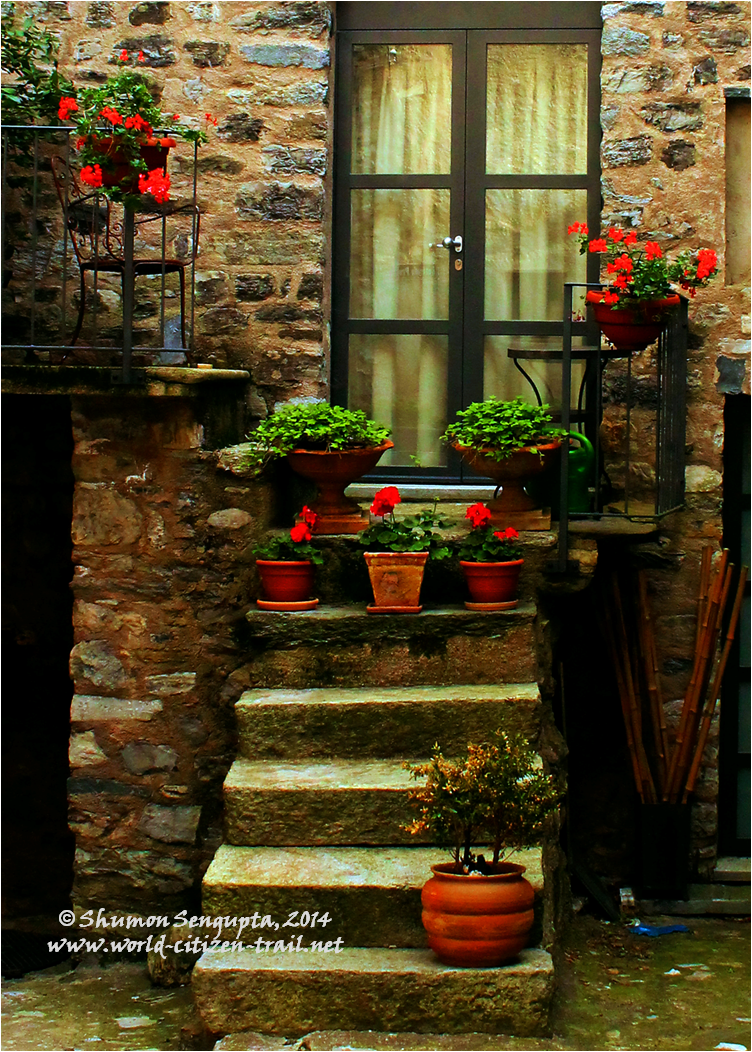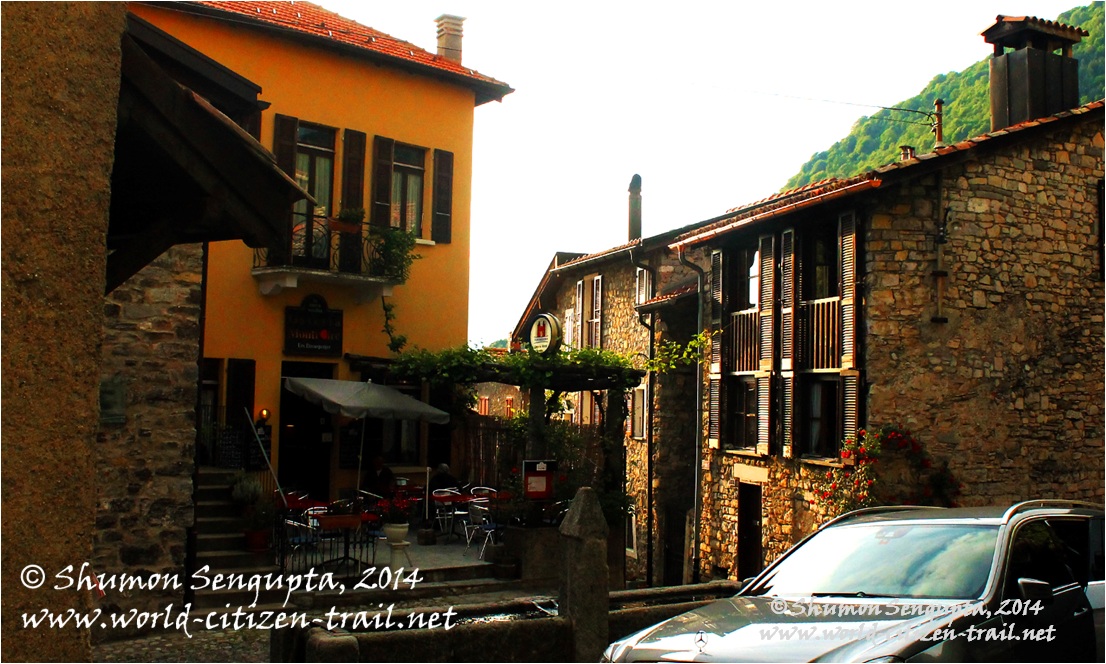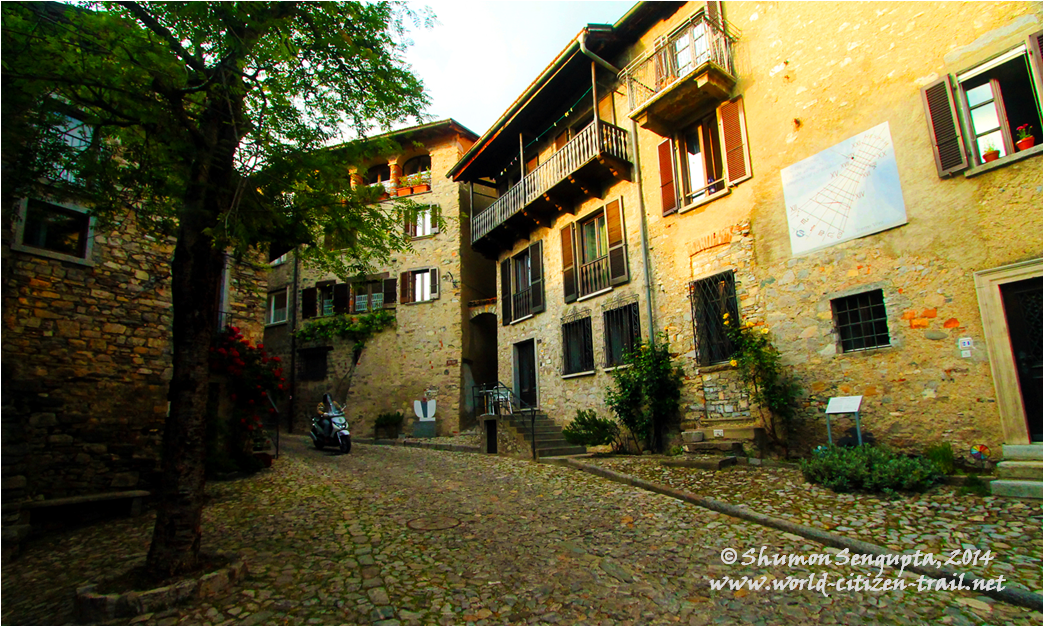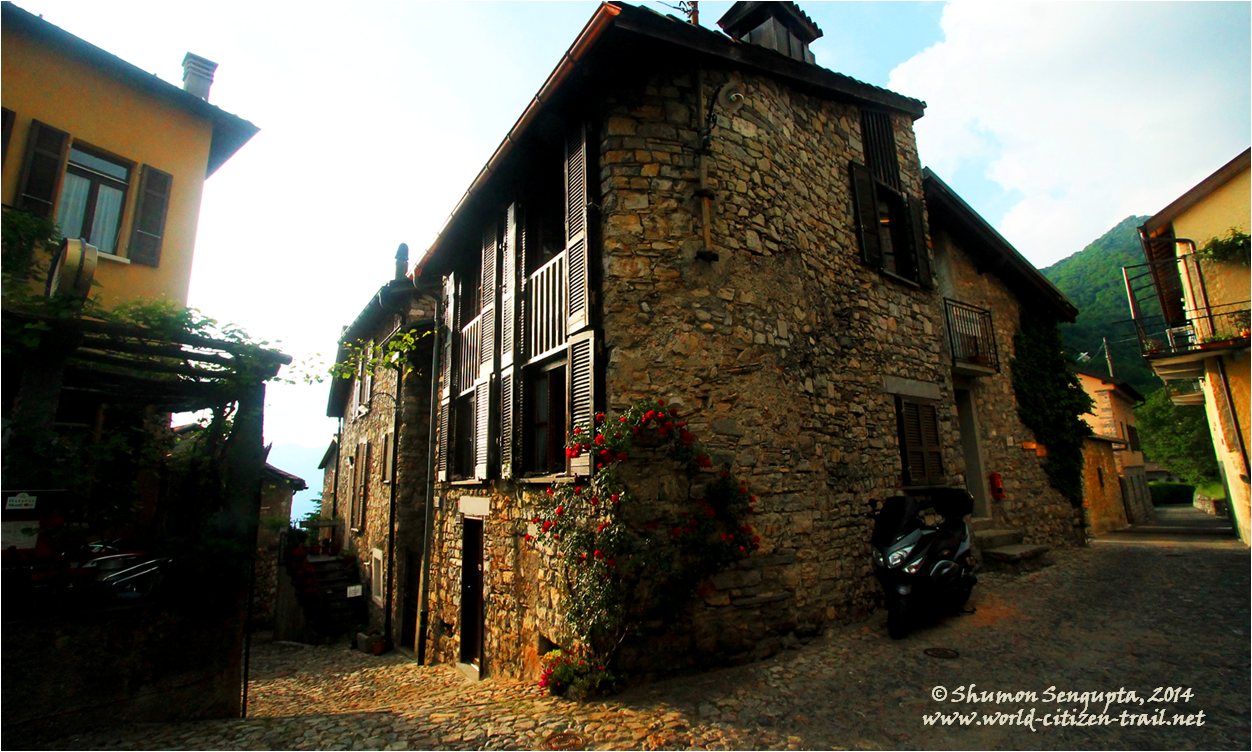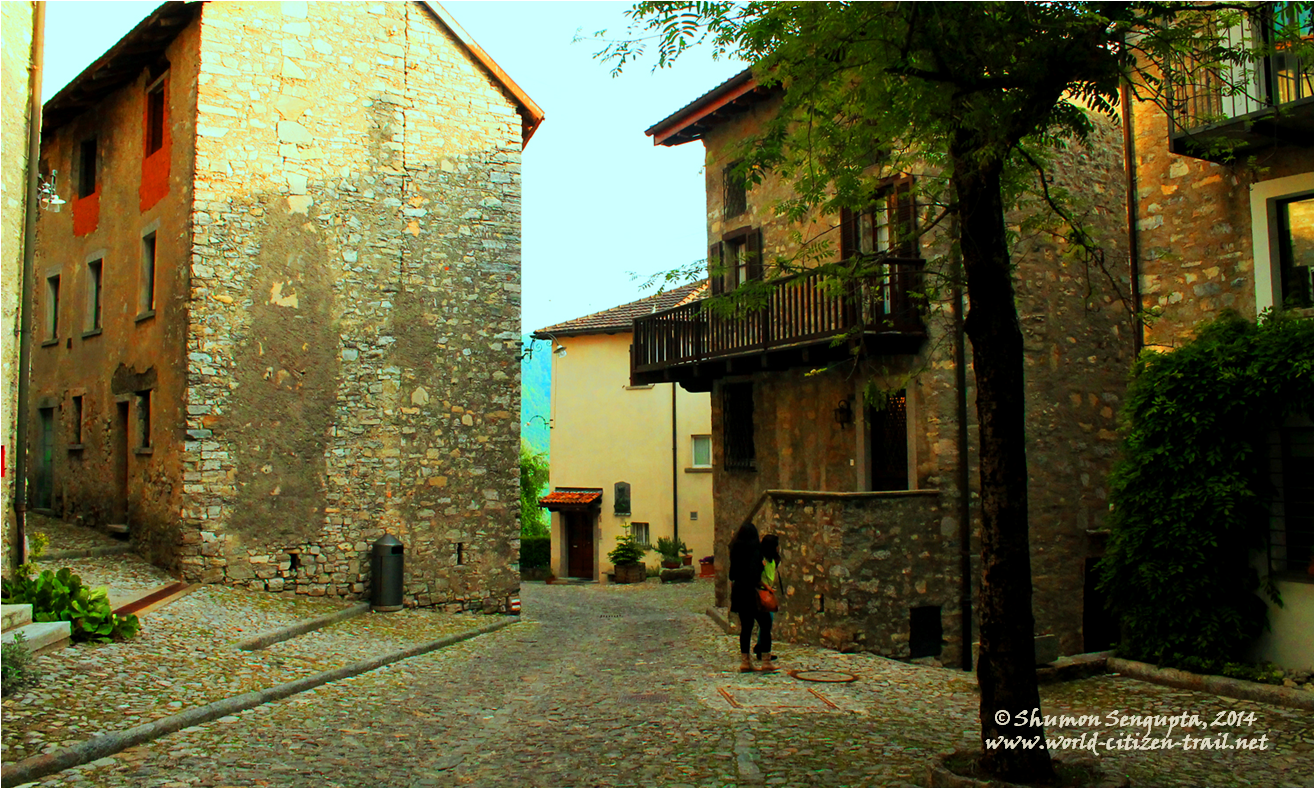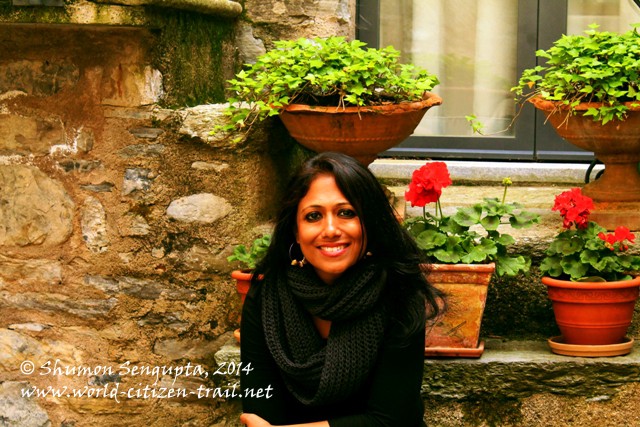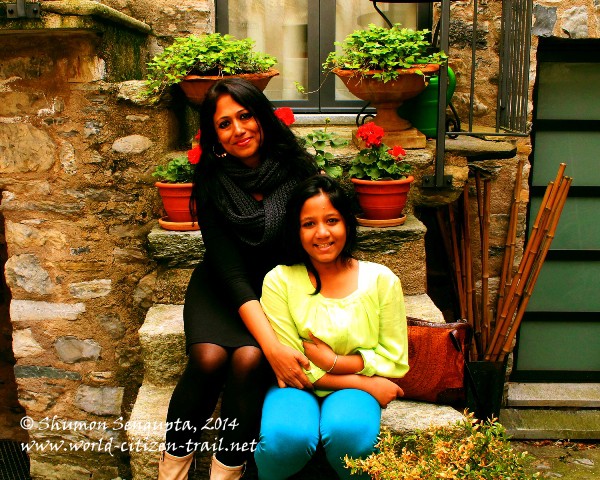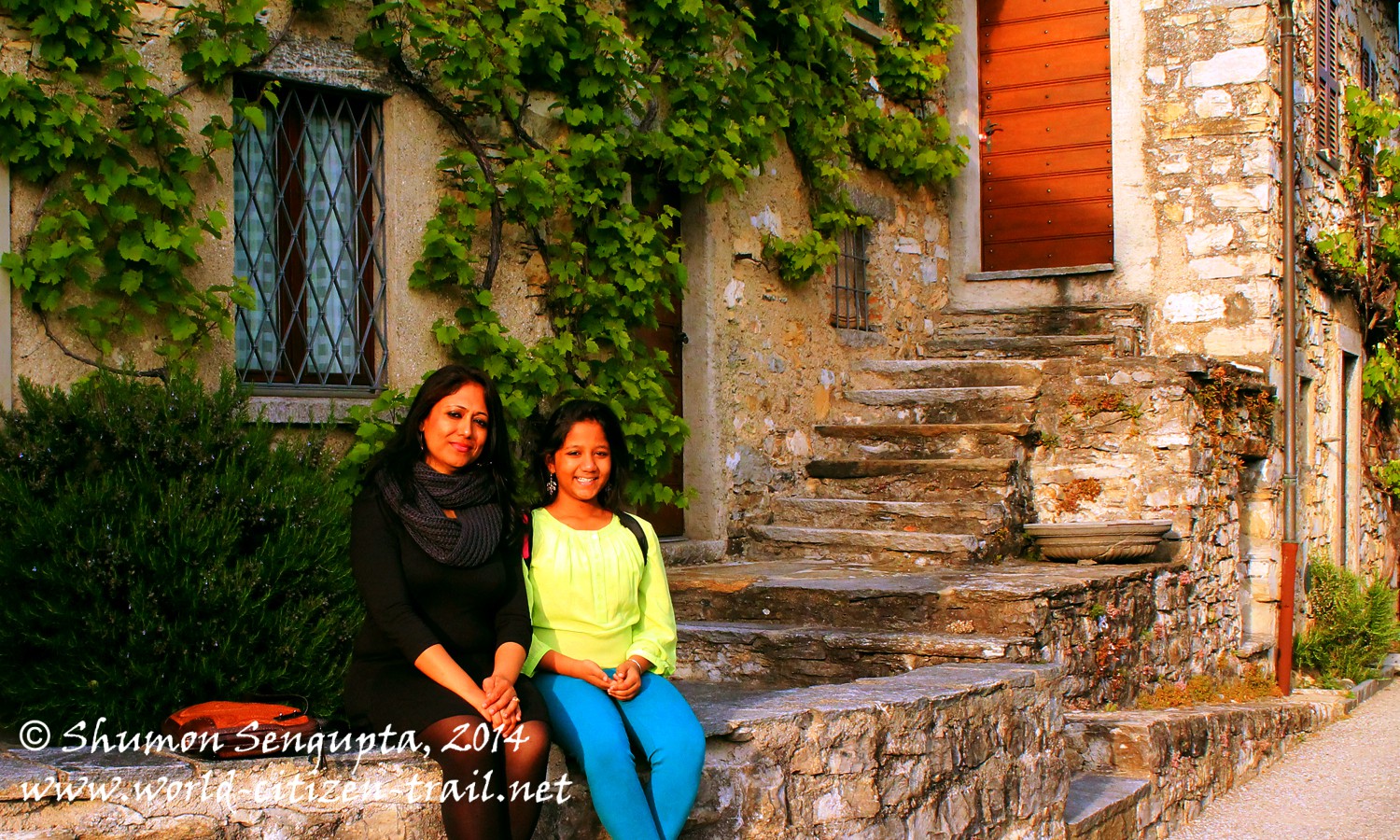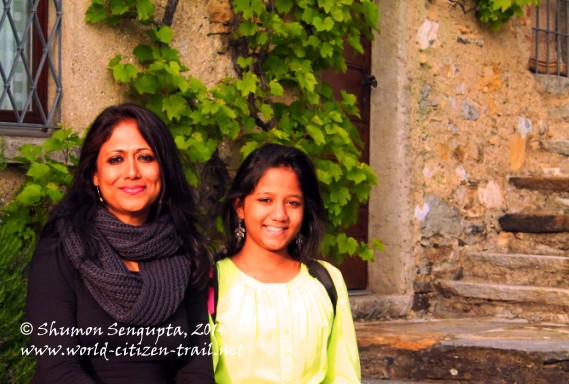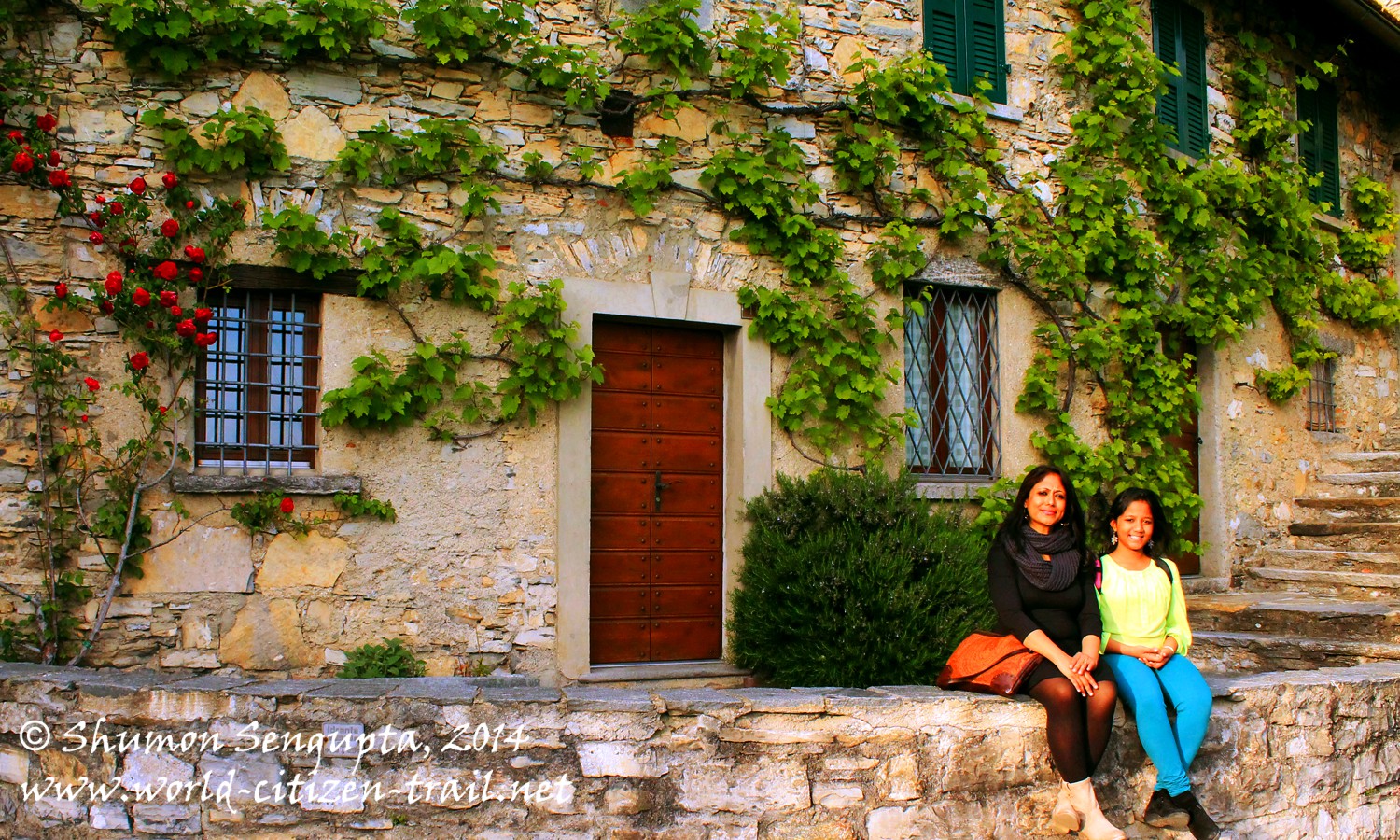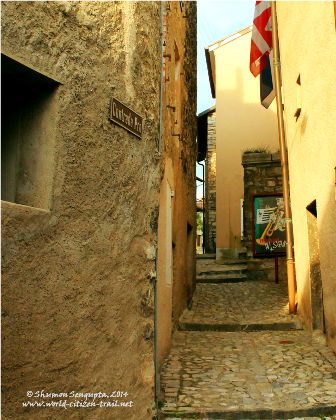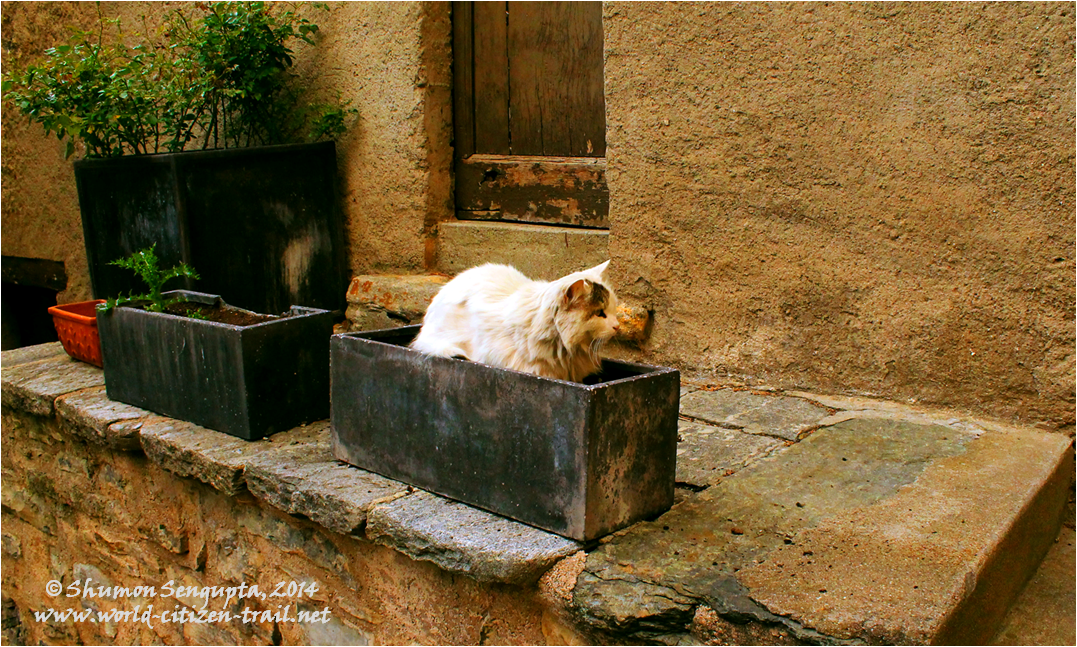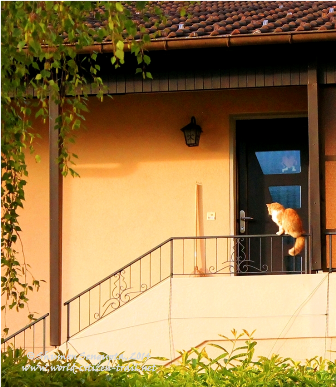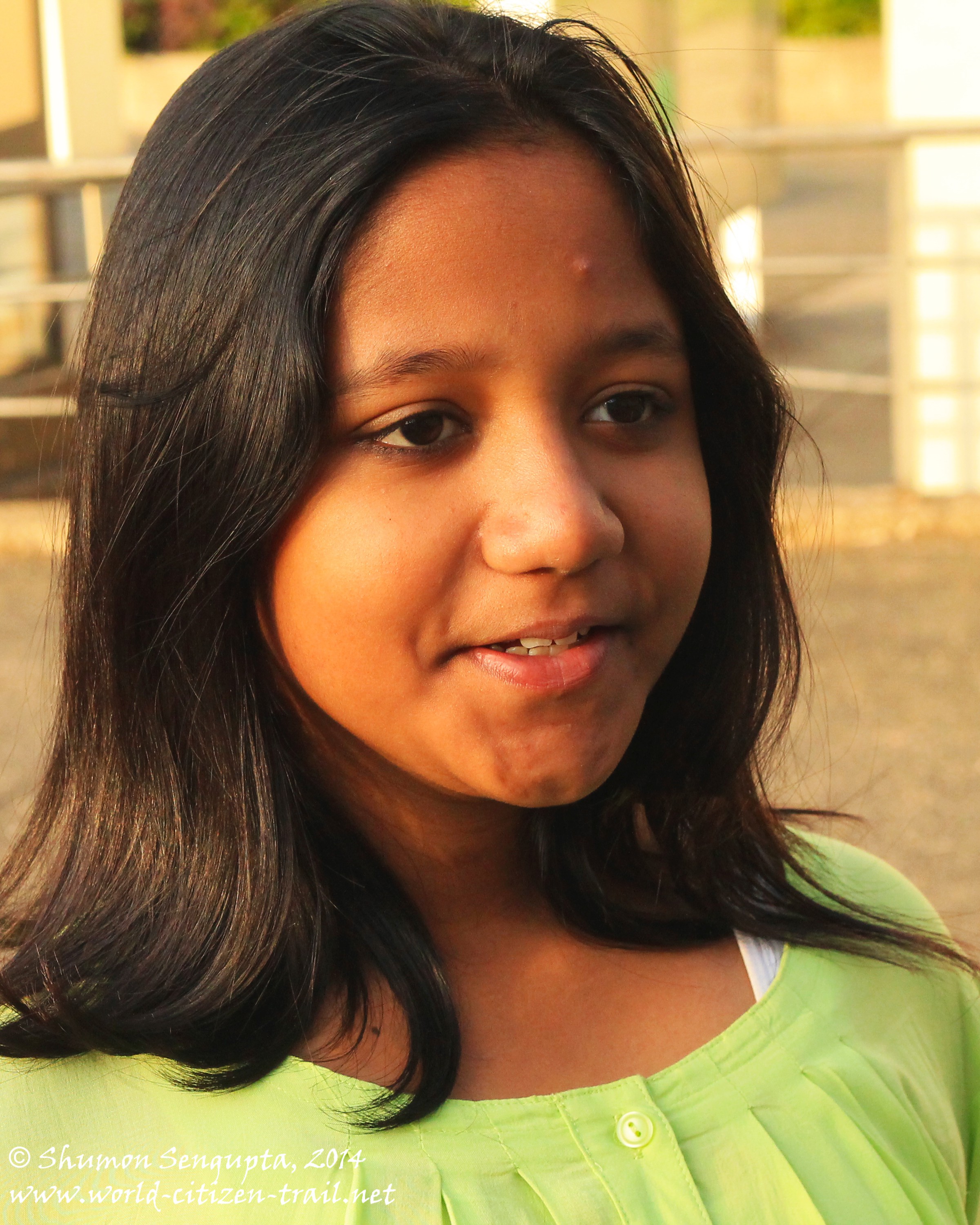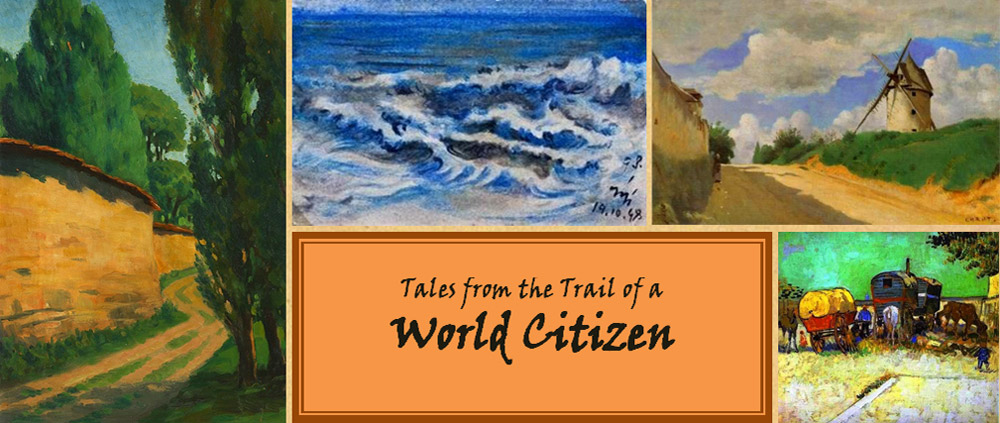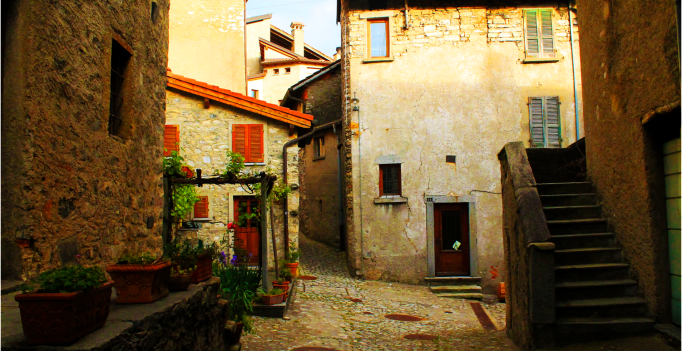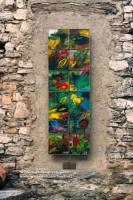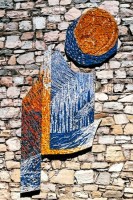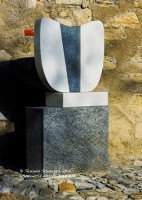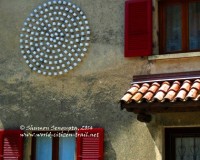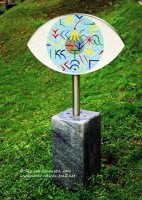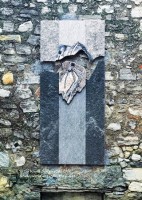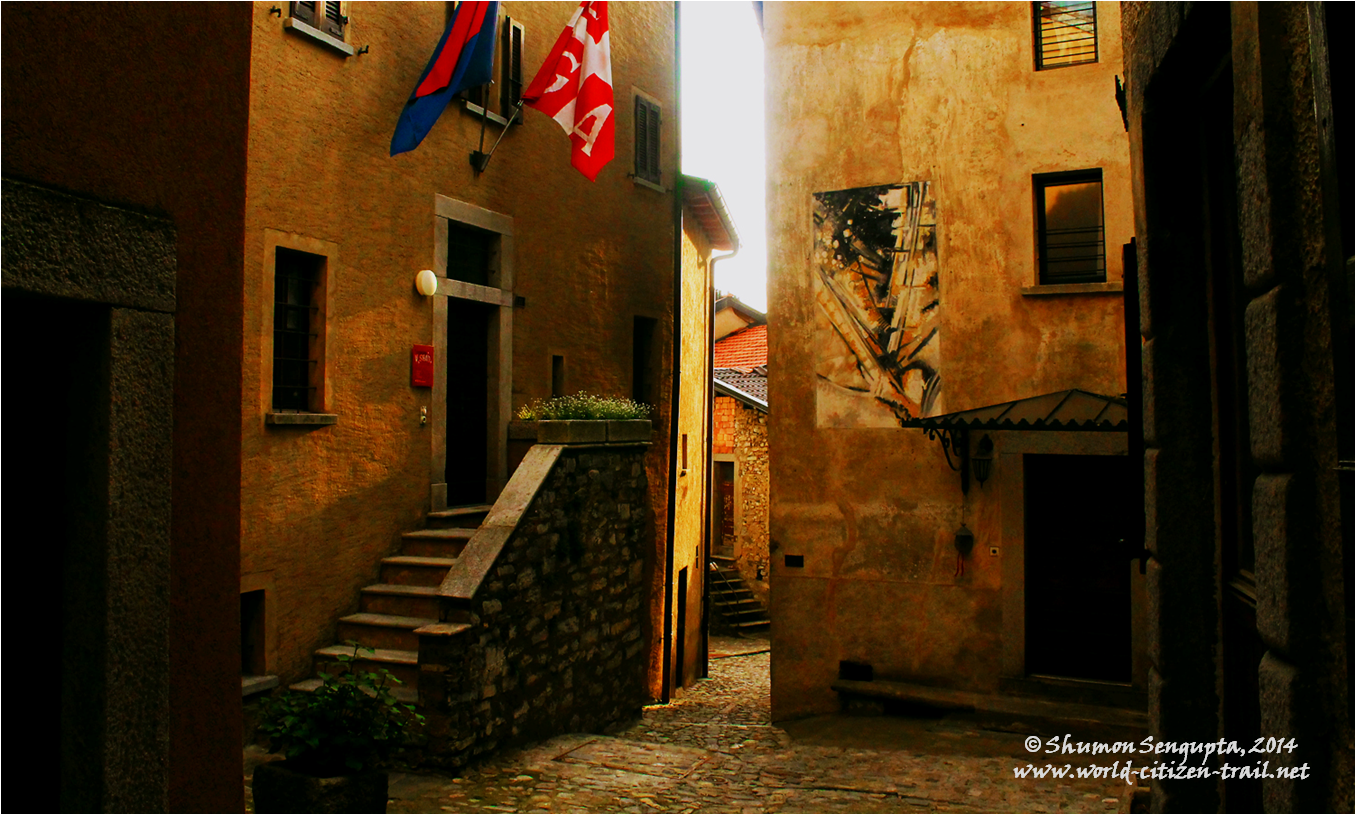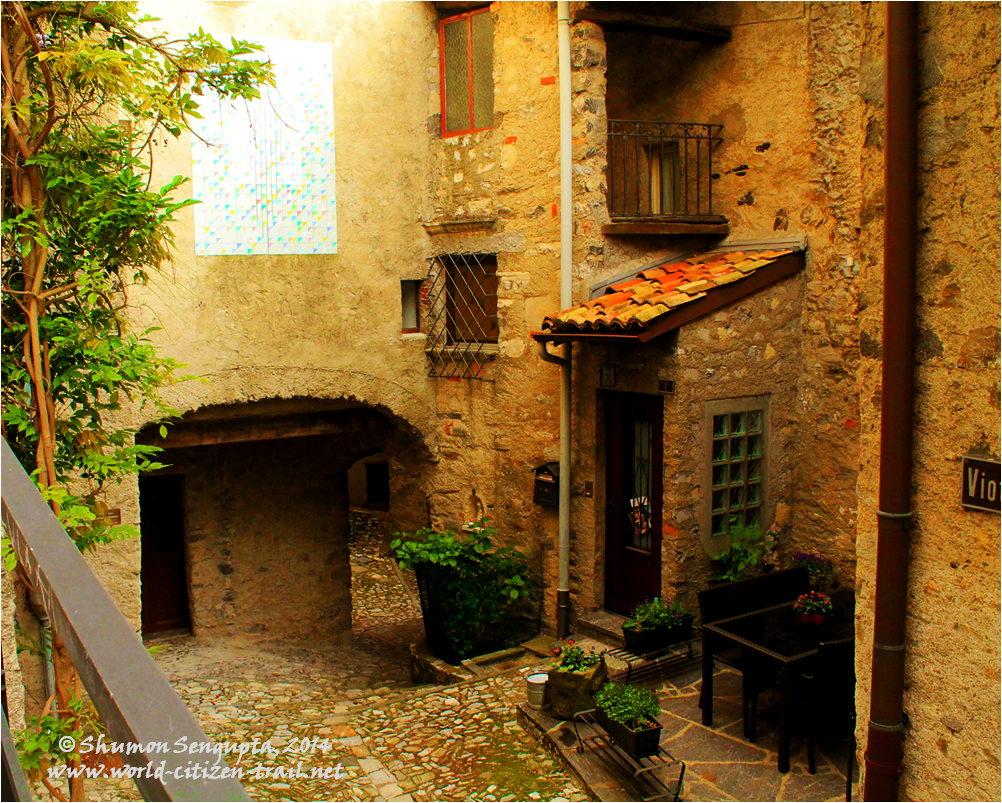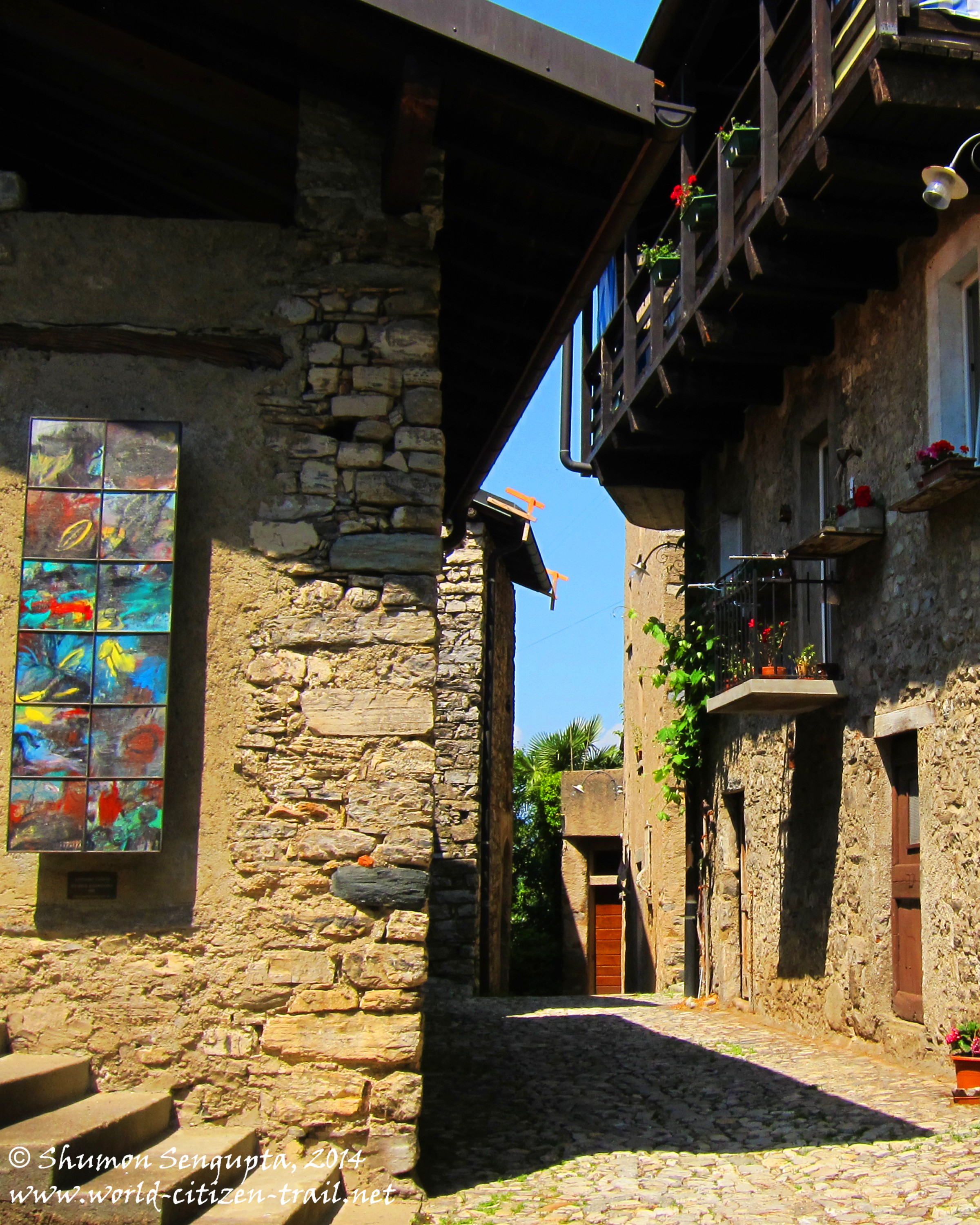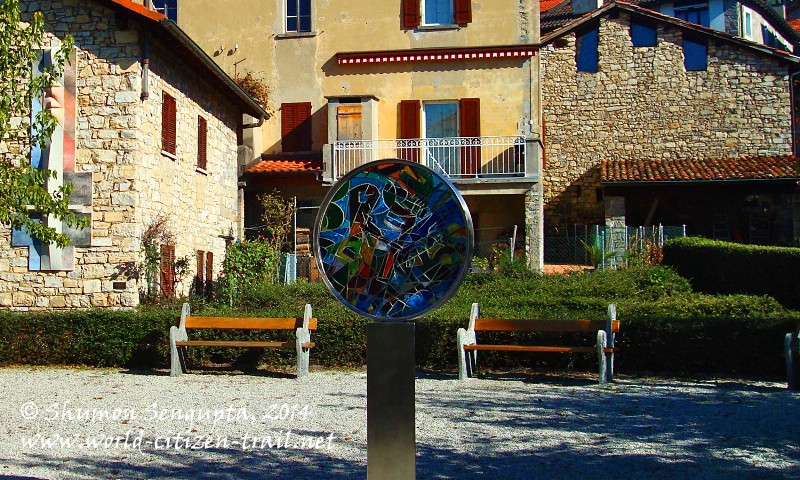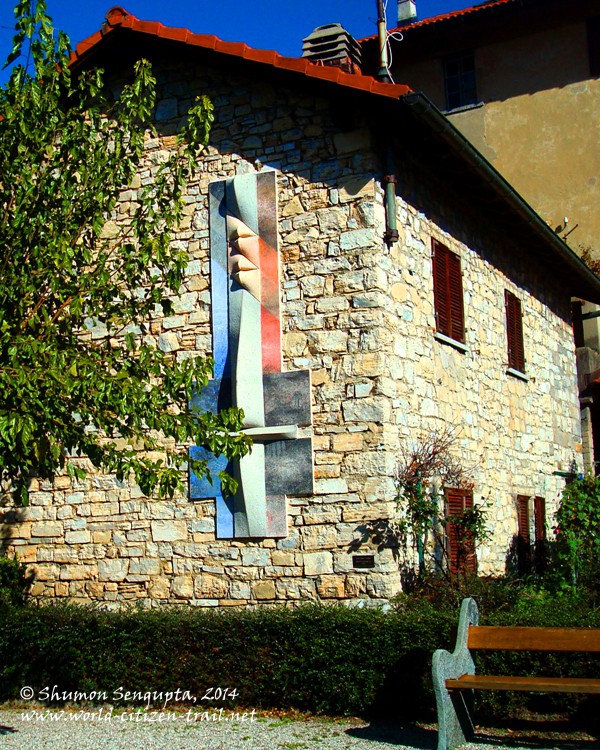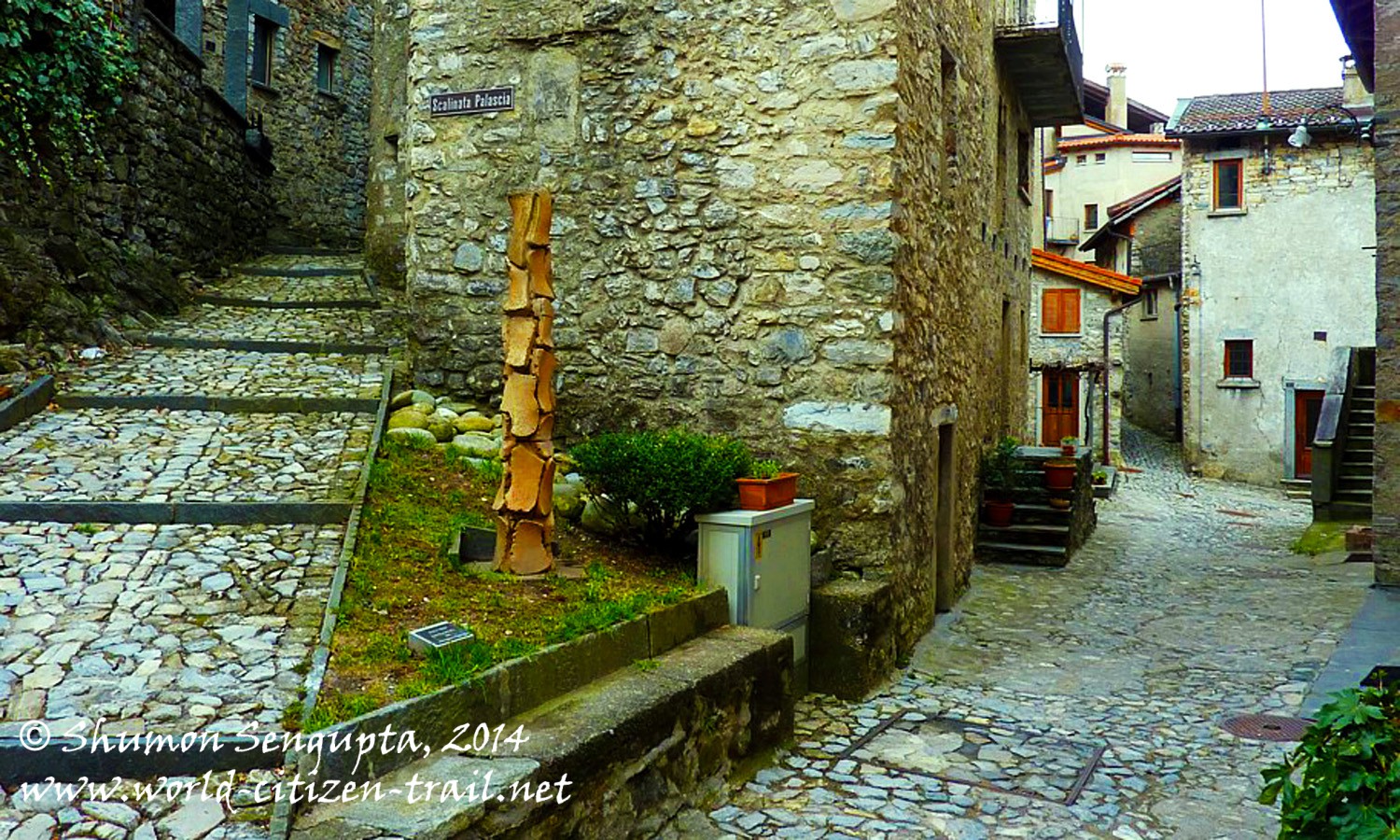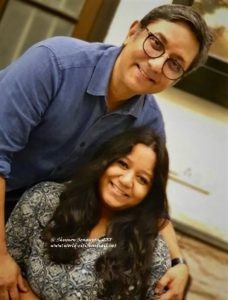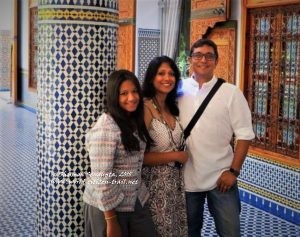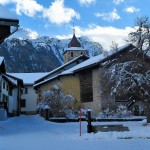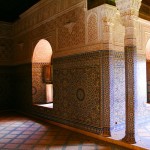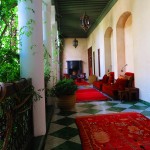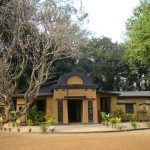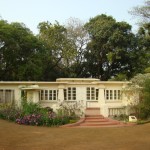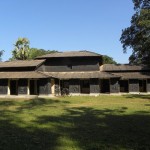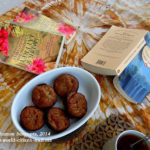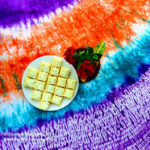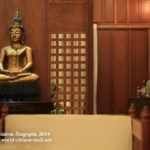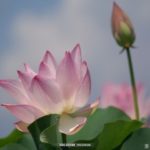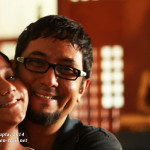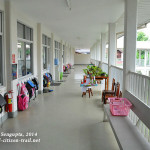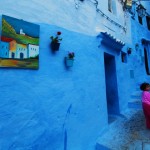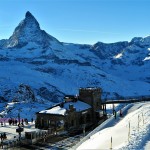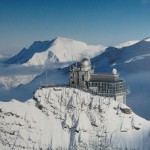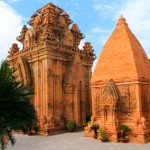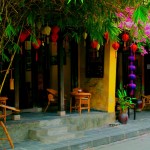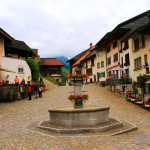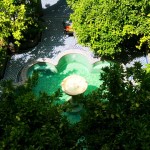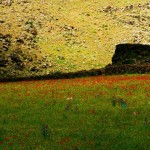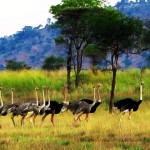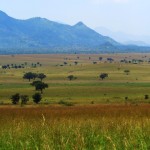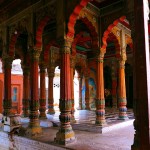***************************************************************
Setting off from the summit of Monte Brè (described in my previous post), we took the trail in the direction of the village of Aldesago, walking downhill along the eastern slope of the mountain. Our destination was the Village (or paese in Italian) of Brè, situated between Monte Brè and Aldesago.
After a leisurely walk of about 15-20 minutes we reached a small terrace – a narrow triangular ledge that provided a bird’s eye view of the village of Brè below, overlooking Lake Lugano. We stopped at this little terrace and sat on the circular bench under a small tree to take in the views. We also refilled our water bottles from the little fountain. And then, a short downhill walk from there over a long and sweeping flight of stone steps, we descended into the village of Brè, at 785 meters above sea level. 
 Approaching the village from above, we arrived at its most visible landmark – the Church of Saints Simon and Fedele, with its Romanesque bell tower. This church is said to date back to medieval times. It contains art works from different eras, including 17th-century frescos by unknown artists and 20th-century paintings by Jozeph Birò, the Hungarian painter who once lived in this village. By the time we reached the village, the church had closed, so we missed seeing its interiors. On the side of the church was a flower decked cemetery with a few sculptures. In the cemetery, among other works is the beautiful bas-relief in marble – “La Dea della pace” (The Goddess of Peace) by Pasquale Gilardi.
Approaching the village from above, we arrived at its most visible landmark – the Church of Saints Simon and Fedele, with its Romanesque bell tower. This church is said to date back to medieval times. It contains art works from different eras, including 17th-century frescos by unknown artists and 20th-century paintings by Jozeph Birò, the Hungarian painter who once lived in this village. By the time we reached the village, the church had closed, so we missed seeing its interiors. On the side of the church was a flower decked cemetery with a few sculptures. In the cemetery, among other works is the beautiful bas-relief in marble – “La Dea della pace” (The Goddess of Peace) by Pasquale Gilardi. 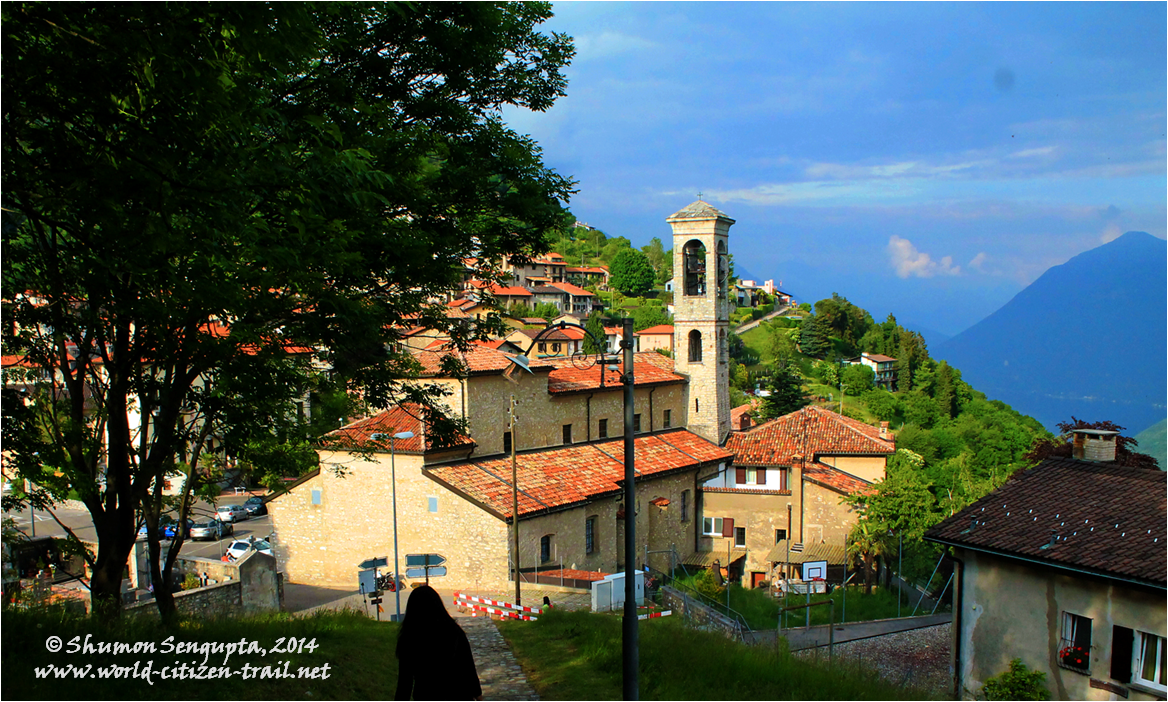

We admired the beautiful view – of the picturesque little sleepy village cradled by the Mountains on all sides, high above lake Lugano. But nothing had prepared us fully for what was to come soon after.
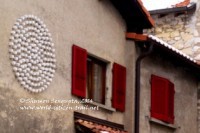 Village Brè has had a rather humble past – even a century back it was a farming village, accessible only on foot or on mule. The construction of the funicular in 1912 however changed the fortunes of this sleepy little village. It is now a up-market and ‘elite’ residential enclave – residents no longer engaged in farming for their livelihoods.
Village Brè has had a rather humble past – even a century back it was a farming village, accessible only on foot or on mule. The construction of the funicular in 1912 however changed the fortunes of this sleepy little village. It is now a up-market and ‘elite’ residential enclave – residents no longer engaged in farming for their livelihoods.
In this quaint little village, we found well preserved, quintessentially Ticinese architecture with its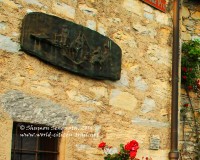 stone houses, finished with a layer of coarse plaster. And intimately intertwined with these were the labyrinth of narrow meandering cobbled stone alleys, lanes and passages, stairs, grottos, porticos, hanging wooden balconies, courtyards, and old stone fountains. We also found the old and traditional communal washing fountain called “Lavatoio”, which is now a preserved
stone houses, finished with a layer of coarse plaster. And intimately intertwined with these were the labyrinth of narrow meandering cobbled stone alleys, lanes and passages, stairs, grottos, porticos, hanging wooden balconies, courtyards, and old stone fountains. We also found the old and traditional communal washing fountain called “Lavatoio”, which is now a preserved 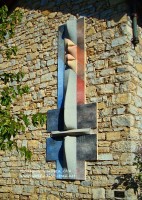 structure. We had seen something similar in the village of Soglio (described in another post) in the Italian speaking part of Graubunden.
structure. We had seen something similar in the village of Soglio (described in another post) in the Italian speaking part of Graubunden.
This pretty little village had not changed noticeably in its external appearance in the last 100 years, I was told. It had successfully preserved its old, traditional architectural features of a typical Ticinese country settlement. Modern times and changing fortunes had not altered the tranquility and appeal of this place – an old world charm still hung in the air.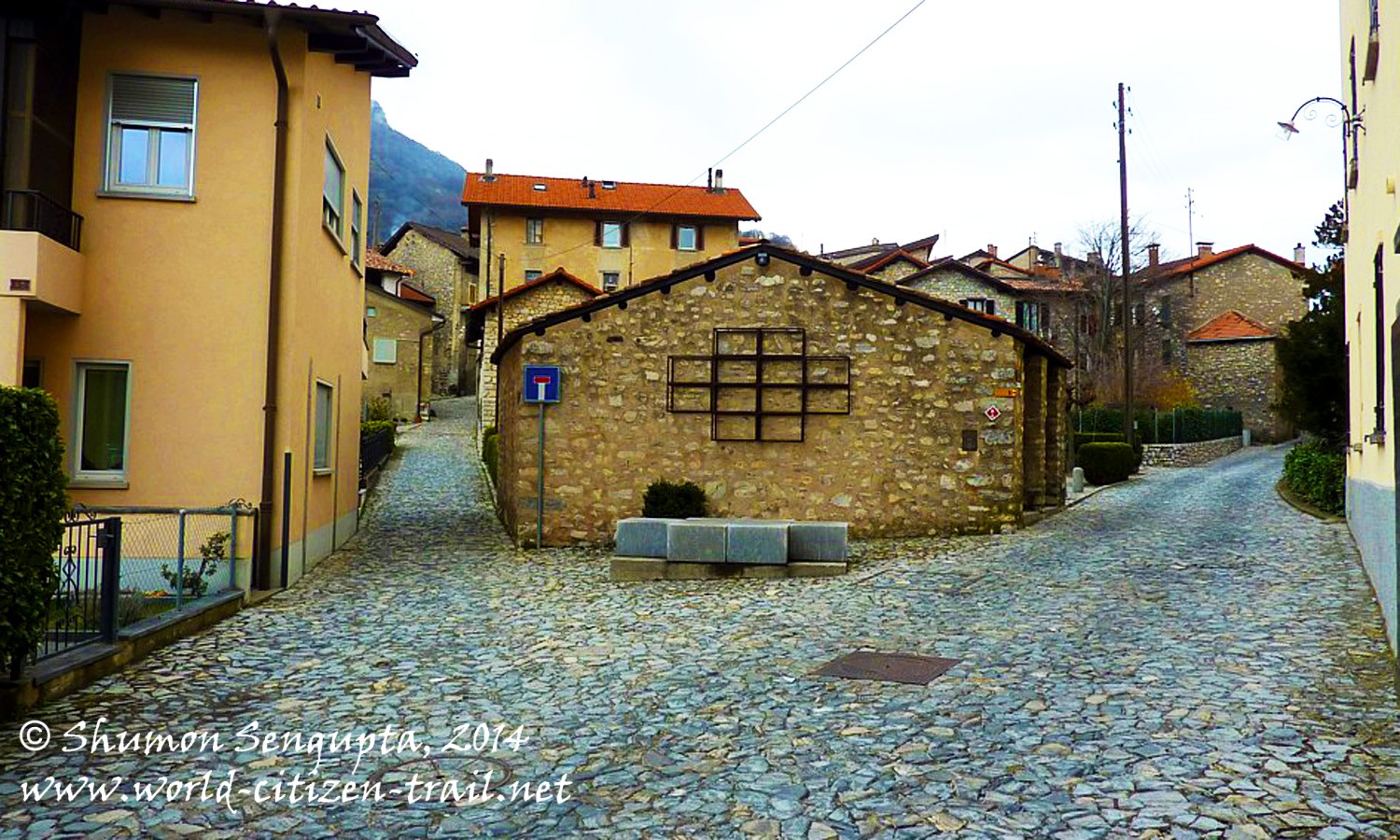




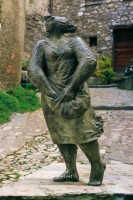 Despite its rustic origins and relative isolation, or more likely because of these, over the centuries, this village has cradled artists of prominence. Artists Pasquale Gilardi (1885 – 1934) and Luigi Taddei (1898- 1992) were both born in this village. And Swiss painter Wilhelm Schmid (1892-1971) and Hungarian Painter Josef Birò (1887-1975) lived here for considerable lengths of time.
Despite its rustic origins and relative isolation, or more likely because of these, over the centuries, this village has cradled artists of prominence. Artists Pasquale Gilardi (1885 – 1934) and Luigi Taddei (1898- 1992) were both born in this village. And Swiss painter Wilhelm Schmid (1892-1971) and Hungarian Painter Josef Birò (1887-1975) lived here for considerable lengths of time.
While these famous artists from past eras are no more, their spirits linger on in this tiny village of around 300 plus residents. This enchanting village is dotted with frescoes, murals, sculptures, installations and other art works of contemporary artists. Works of Aligi Sassu, Armando Losa, Gianfredo Camesi, Emilio Rissone, Mariapia Borgnini and Fra Roberto Pasotti (source www.lugano-tourism.ch) can be found along a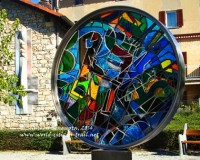 small trail in the village center – around corners, in little niches, on the side of paved alleys and above grottos and in the middle of little village squares. This art trail is supported by the Society of Swiss Painters, Sculptors and Architects. At the center of the village stands the house of Wilhelm Schmid (the exponent of the Nordic “New Objectivity” and “Magic Realism”), which has now been converted into a museum of his works.
small trail in the village center – around corners, in little niches, on the side of paved alleys and above grottos and in the middle of little village squares. This art trail is supported by the Society of Swiss Painters, Sculptors and Architects. At the center of the village stands the house of Wilhelm Schmid (the exponent of the Nordic “New Objectivity” and “Magic Realism”), which has now been converted into a museum of his works.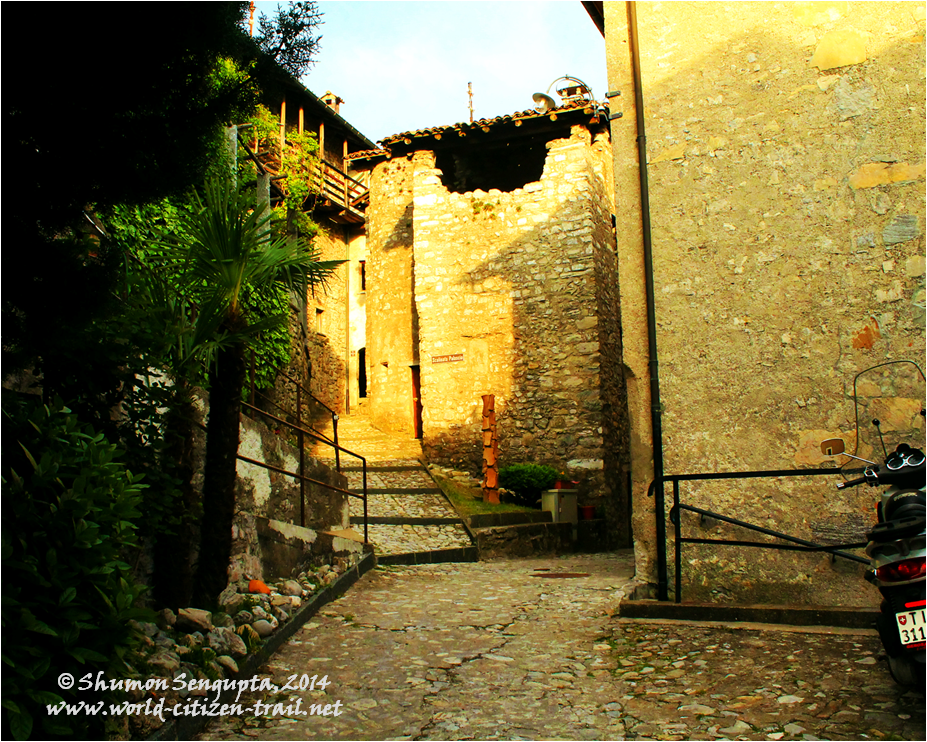

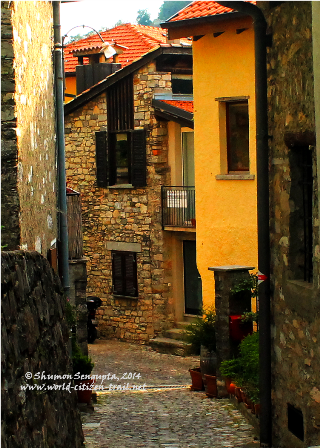
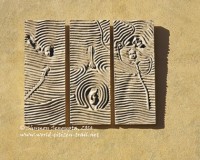 As we strolled on the old cobblestoned paths along the art trail, we wondered what work of beauty would pop up around the next corner and sure enough, there would be a mural, a sculpture or an installation waiting for us to admire. Almost every turn presented a surprise in terms of an installed work of art. The entire village, along with its incredibly beautiful old-world stone houses and narrow cobble-stone lanes and alleys, appeared like one big ‘walk-by’ outdoor art gallery.
As we strolled on the old cobblestoned paths along the art trail, we wondered what work of beauty would pop up around the next corner and sure enough, there would be a mural, a sculpture or an installation waiting for us to admire. Almost every turn presented a surprise in terms of an installed work of art. The entire village, along with its incredibly beautiful old-world stone houses and narrow cobble-stone lanes and alleys, appeared like one big ‘walk-by’ outdoor art gallery.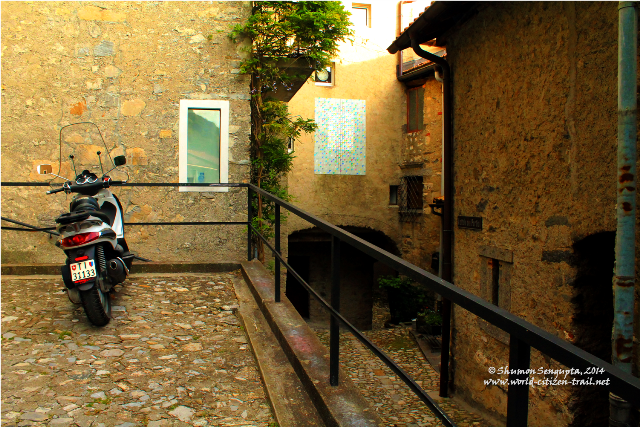
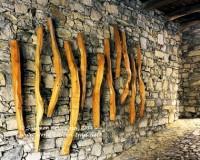 We stopped periodically to admire a wide range of objects of beauty – a cluster of an old porter’s wheel and farming tools and pots hung casually on a stone wall, old machine parts arranged beautifully, a series of irregular horizontal wooden poles on a wall, a work of mosaic above a grotto, a fresco of mountain
We stopped periodically to admire a wide range of objects of beauty – a cluster of an old porter’s wheel and farming tools and pots hung casually on a stone wall, old machine parts arranged beautifully, a series of irregular horizontal wooden poles on a wall, a work of mosaic above a grotto, a fresco of mountain 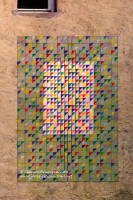 goats etched high up on a wall, a heavy abstract stone sculpture, an abstract metal sculpture of a seated woman and a more realistic one of woman standing, a stained glass installation, stunningly beautiful ceramic and terracotta murals, a simple but arresting rosette of white marble cubes, resembling sugar cubes stuck on a brown wall etc. to the way chopped wood was stacked in the houses, to the curved iron grill of windows, the ornate street lamp, the old stone fountain, the vines and flowering climbers draping stone walls and the random patterns of the cobbled stones.
goats etched high up on a wall, a heavy abstract stone sculpture, an abstract metal sculpture of a seated woman and a more realistic one of woman standing, a stained glass installation, stunningly beautiful ceramic and terracotta murals, a simple but arresting rosette of white marble cubes, resembling sugar cubes stuck on a brown wall etc. to the way chopped wood was stacked in the houses, to the curved iron grill of windows, the ornate street lamp, the old stone fountain, the vines and flowering climbers draping stone walls and the random patterns of the cobbled stones.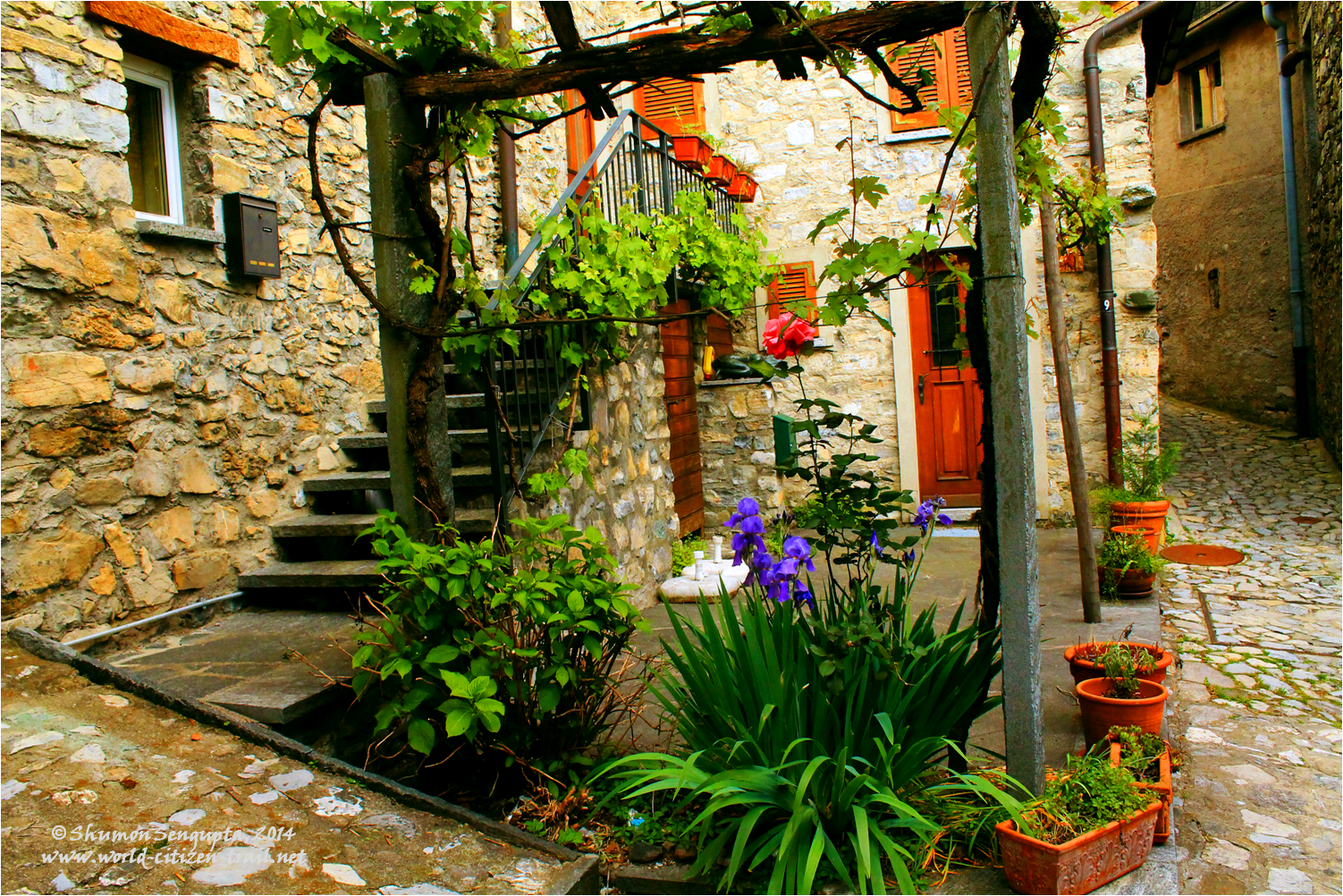
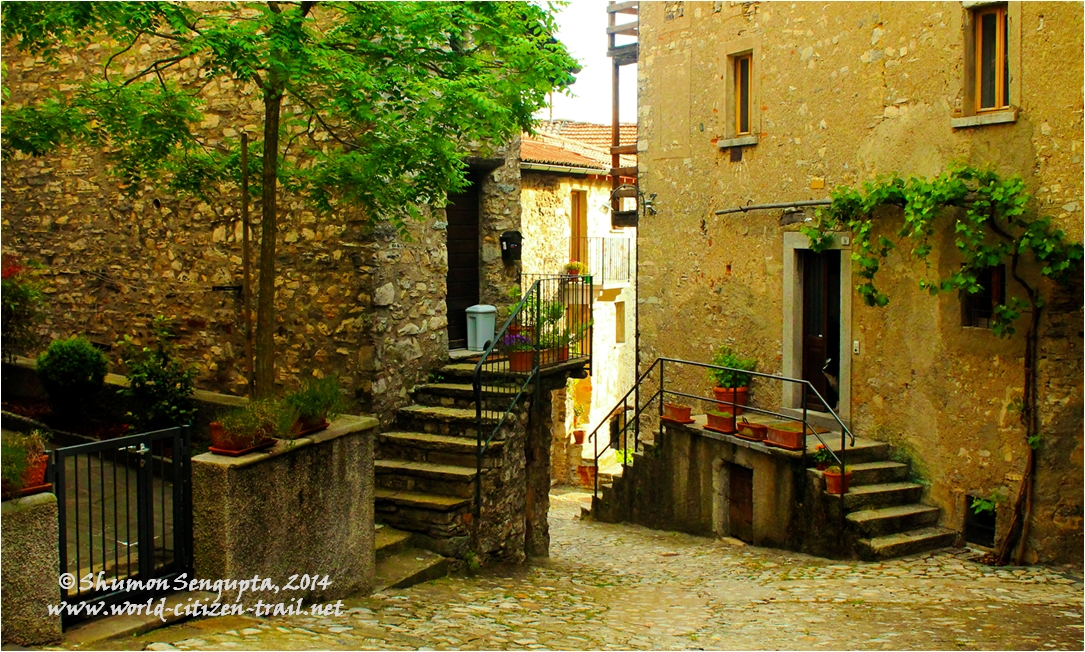 One of the most striking frescoes for me was the one which had a herd of mountain goats executed on a tall wall, overlooking an old stone fountain in a small square. I thought this was a masterpiece.
One of the most striking frescoes for me was the one which had a herd of mountain goats executed on a tall wall, overlooking an old stone fountain in a small square. I thought this was a masterpiece. 

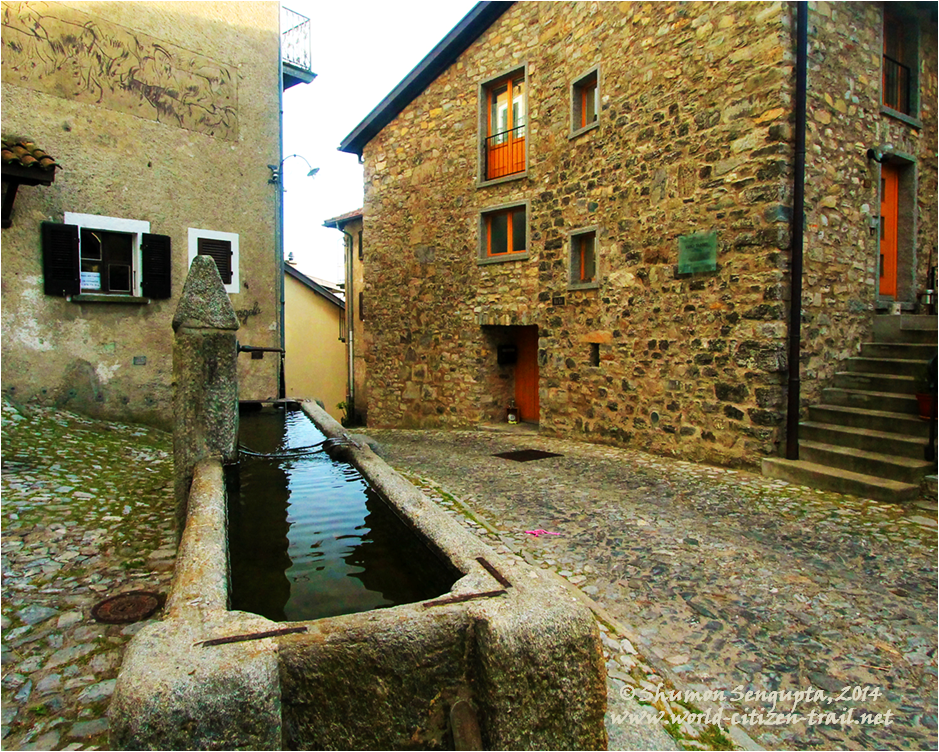
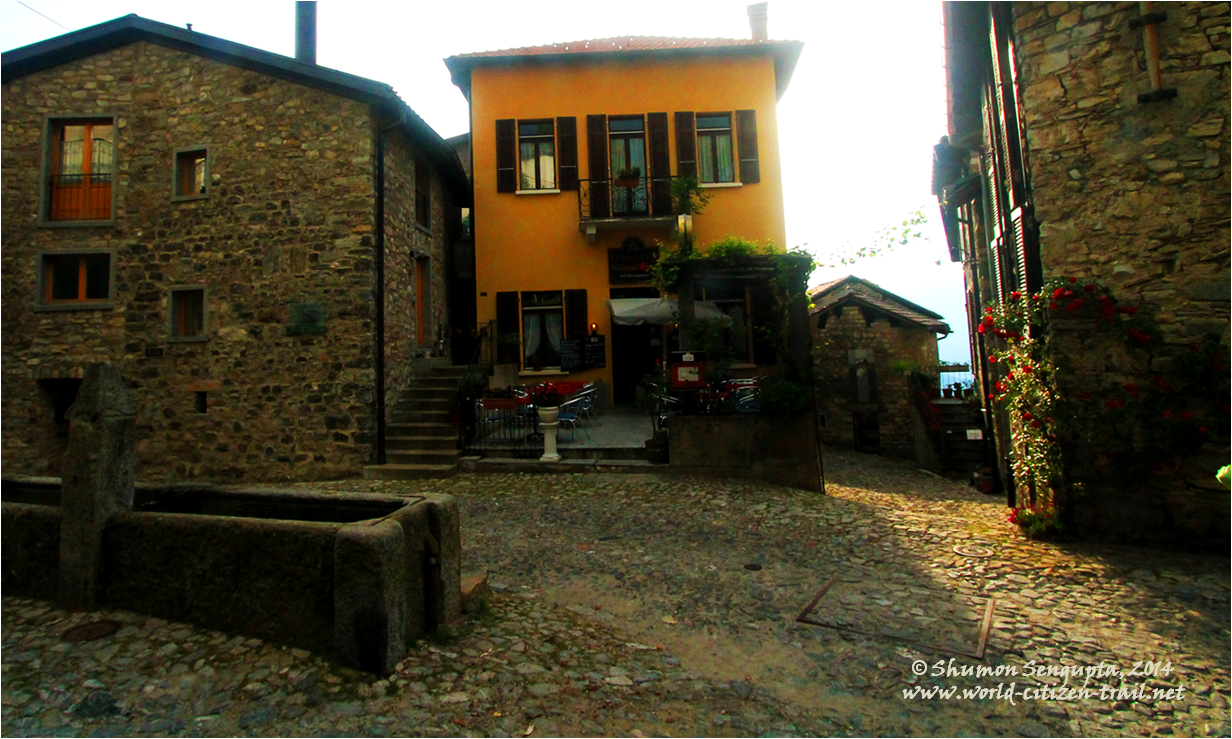
Close to this square is a hiking trail that leads all the way up to Monte Boglia. The path, which is cobbled in parts, passes through a wooded area, with centuries-old beech trees. 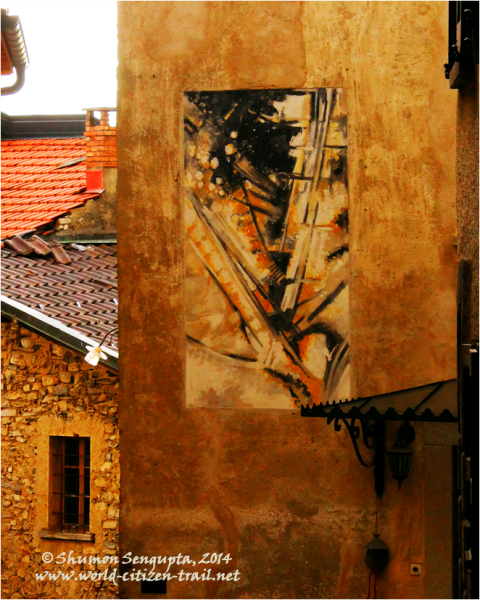
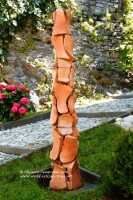 The enchanting little village of Brè was a unique place that combined art, architecture and history, with stunning alpine vistas thrown in. It was a veritable training in aesthetics, not only for me and my wife Nina, but more importantly for my eleven year old daughter, Minnie, who was as captivated
The enchanting little village of Brè was a unique place that combined art, architecture and history, with stunning alpine vistas thrown in. It was a veritable training in aesthetics, not only for me and my wife Nina, but more importantly for my eleven year old daughter, Minnie, who was as captivated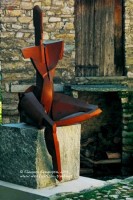 as we were by this place.
as we were by this place.
Indeed as said Hermann Hesse, “words do not express thoughts very well. They always become a little different immediately after they are expressed, a little distorted, a little foolish”.
Suffice to say, Brè wasn’t a village; it was one gigantic, living work of installation art in itself. Once you are in, you don’t just see art – you begin to breathe it and soak in it; if that says anything for this place.
Travelling tips: Check out my post on Monte Brè.


